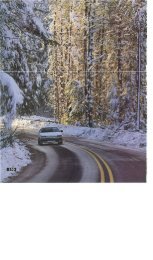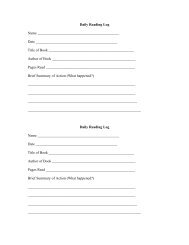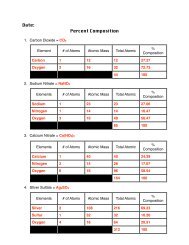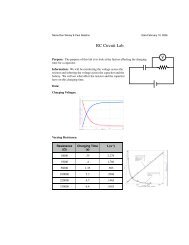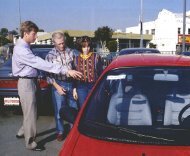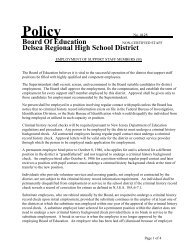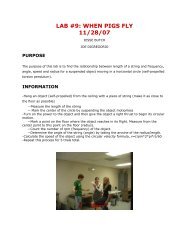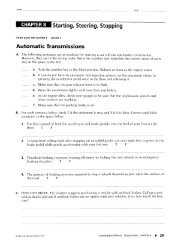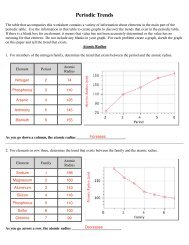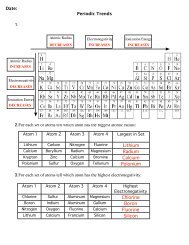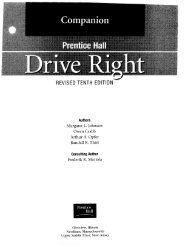You also want an ePaper? Increase the reach of your titles
YUMPU automatically turns print PDFs into web optimized ePapers that Google loves.
<strong>Chapter</strong> 8<strong>Sharing</strong> The <strong>Roadway</strong>EYou Are <strong>the</strong> Driver!As a driver, you will be sharing <strong>the</strong> roaGway with a variety of o<strong>the</strong>r vehicles andpedestrians. These o<strong>the</strong>r users present <strong>the</strong>irown special problems in every drivingenvironment. Many vehicles are small insize and, like pedestrians, have very littleprotection if a conflict with a largervehicle occurs, A. .L *'at problems might <strong>the</strong> motorcycXstand bicyclist have in this traffic scene?What should <strong>the</strong> car driver predict? Thischapter explores problems presented byo<strong>the</strong>r roadway users and explains yourresponsibility for protecting o<strong>the</strong>r less-.. 7hiprotected users.- ,t4 t8.1<strong>Sharing</strong> <strong>the</strong> <strong>Roadway</strong> withMotorcyclists8.2Motorcyclist Actions CanAffect You8.3Bicycles, Mopeds, andMotor Scooters8.4Pedestrians andSpecial Vehicles8.5<strong>Sharing</strong> <strong>the</strong> Road with TrucksTake it to <strong>the</strong> NETPHSchool.com/driverightC<strong>Chapter</strong> 8 <strong>Sharing</strong> <strong>the</strong> <strong>Roadway</strong> 149
ilarine <strong>the</strong> Roadwav with Motorcvclists150 Unit 2 Controlling Your Vehicleven though many drivers willE never ride a motorcycle, <strong>the</strong>y willbe safer drivers if <strong>the</strong>y understandproblems involved in <strong>the</strong> cyclist'sdriving task. Motorcyclists have <strong>the</strong>same privileges within <strong>the</strong> HTS asdrivers of o<strong>the</strong>r vehicles. They alsoshare an equal responsibility for followingsafe driving practices.Even though motorcycle registrationsmake up a very small percentageof all vehicle registrations, about2,000 cyclist fatalities occur each year.Injuries and deaths from motorcyclecrashes result primarily from <strong>the</strong>exposed position of <strong>the</strong> rider. Unlike<strong>the</strong> driver of a larger vehicle, amotorcyclist has little or no protectionwhen conflicts occur.As a driver of a larger vehicle,you must accept <strong>the</strong> major share ofresponsibility for protecting motorcyclistsas <strong>the</strong>y interact within <strong>the</strong>HTS. Show cyclists <strong>the</strong> same courtesyyou show o<strong>the</strong>r drivers.Wnp tlre IPDE ProcessMost low-risk drivers tend to be alertfor o<strong>the</strong>r cars and larger vehicles thatmight cause conflict. Because motorcyclesare smaller and are driven inseveral different lane positiohs, <strong>the</strong>yoften are not identified in time toprevent conflict. Make a specialeffort to use <strong>the</strong> IPDE Process.The Identify step is crucial fordrivers because motorcycles are moredifficult to see. Search all <strong>the</strong> zones soyou will not be surprised by <strong>the</strong> suddenappearance of a motorcycle.Predict actions of motorcyclists thatmight enter your path. Base yourdecisions on <strong>the</strong> problems that confront<strong>the</strong> motorcyclist, and executeyour actions. Use every techniquepossible before a closed zone orconflict occurs. The driver in <strong>the</strong>yellow car in <strong>the</strong> picture is lookingthrough <strong>the</strong> approaching car's windowsto see <strong>the</strong> motorcyclist or o<strong>the</strong>rroadway users.to Look f- Motomycrld7wok for motorcp~~bts ir "-c fouuwing situations.Vehide Turning Left in Front ofMotorcydist When you plan to turnleft across one or more lanes of traffic,be sure your planned path of travel isclear. Even though <strong>the</strong> cyclist in <strong>the</strong>top picture on <strong>the</strong> opposite page issignaling for a left turn, <strong>the</strong> car driver-Scan mrough <strong>the</strong> windows of o<strong>the</strong>r vehiclesto see motorcyclists or o<strong>the</strong>r roadway users.
should predict that <strong>the</strong> cyclist will continuestraight. The car driver shouldcomplete <strong>the</strong> left turn only after scanningfront and side zones and after <strong>the</strong>cyclist has entered his left-turn path.When you make left turns atnight, be especially watchful foroncoming vehicle headlights. Thesingle headlight of a motorcycle canbe confused with a larger vehicle thathas only one working headlight.Vehicle Turning Right at Intersectionor Driveway Drivers of larger vehicleswho do not check <strong>the</strong>ir rear zonesfrequently might not be aware of trafficto <strong>the</strong> rear. Therefore, <strong>the</strong>y mayturn right directly in front of a motorcyclist,as <strong>the</strong> picture below shows.Motorcyclist Tuning Left Whenyou are approaching an intersectionand <strong>the</strong>re is oncoming traffic, expectAre <strong>the</strong> Driver1How could you haveavoided a possible conflictwith this motorcyclist?<strong>Chapter</strong> 8 <strong>Sharing</strong> <strong>the</strong> <strong>Roadway</strong> 15 1
Motorcyclists shouldnever assume that allo<strong>the</strong>r drivers see <strong>the</strong>m.They should makeevery effort to be asvisible as posribk in<strong>the</strong> traffic scene.152 Unit 2 Controlling Your Vehi,smaller vehicles to appear in yourpath. An approaching motorcyclistwho is about to turn left could beblocked from your view. Search yourfront zones and be aware of anylimited sight distance to your left.Be prepared to act to avoid conflict.Motorcyclist in Driver's Blind SpotBecause of its relatively small size, amotorcycle is often difficult to see in<strong>the</strong> blind-spot areas behind yourvehicle. The roof-support columns on<strong>the</strong> back and sides of vehicles add to<strong>the</strong> problem. Always check <strong>the</strong> blindspots in your left- and right-rearzones by glancing over your shoulderbefore turning or changing lanes.Tailgating Motorcyclist The onlyway to know if you are being tailgatedby a motorcyclist is to check your rearzone often. When you see a tailgatingcyclist, try to avoid sudden braking.If <strong>the</strong> driver of <strong>the</strong> yellow car in <strong>the</strong>picture brakes suddenly to let <strong>the</strong>car on <strong>the</strong> shoulder in, <strong>the</strong> tailgatingmotorcyclist could lose control. Themotorcyclist does not have enoughfollowing distance to stop in time.Check your rearview mirrors oftenand increase your following distanceif a cyclist is following you.Motorcyclist Passing Vehicle onRight or Left Check your reartiewmirrors and blind spots fredently aspart of your visial search pattern.Anticipate that motorcyclists willpass you. The failure of many driversto check <strong>the</strong>ir rearview mirrors andblind-spot areas can easily lead toconflict with motorcyclists.Be especially aware of beingpassed on ei<strong>the</strong>r <strong>the</strong> right or left atWatch for tailgating motorcyclists if you mustslow or stop suddenly.an intersection where <strong>the</strong>re may bemore space. Even though motorcyclistsshould not pass at intersections,always watch for <strong>the</strong>m so youcan avoid conflict. When you arebeing overtaken by a motorcyclist,maintain both your lane positionand your speed.Motorcyclist Meeting an OncomingVehicle You are more likely to seean oncoming motorcyclist in <strong>the</strong>daytime if <strong>the</strong> motorcycle's headlightis on. Many states require that <strong>the</strong>motorcycle's headlight be on at alltimes. All motorcycles manufacturedtoday haw <strong>the</strong> headlight come onwhen <strong>the</strong> ignition is turned on.Whenever you see an oncomingmotorcyclist, stay on your side of <strong>the</strong>roadway until <strong>the</strong> motorcyclist haspassed. Remember also that havingyour headlights on at all times makesyou more visible to <strong>the</strong> cyclist.
never tailgate a cyclist before passing.The appearance of a very closevehicle in <strong>the</strong> cyclist's rearviewmirror could cause an unexpectedaction and result in conflict. Whenyou plan to overtake and pass amotorcyclist, stay well back untilyou start to pass.When <strong>the</strong> way is clear, executeyour passing maneuver. Use <strong>the</strong>entire left lane for passing, as <strong>the</strong> cardriver in <strong>the</strong> picture is doing. Whenyou can see <strong>the</strong> cyclist in yourrearview mirror, signal, check yourright blind-spot area, and return to<strong>the</strong> right lane.Protecting MotorcydlstsUnlike a driver protected inside alarger vehicle, a motorcyclist is fdlyexposed to dangers that could causeinjury or death. For this reason,you must accept an extra share ofresponsibility for avoiding conflictswith cyclists. With a larger vehicleunder your control, you have <strong>the</strong>power to cause far more harmthan a cyclist. Handle this powerwith respect.Develop an attitude of helpingo<strong>the</strong>rs who are less protected. Makeit your responsibility to demonstratehabits and behavior that show youcare for <strong>the</strong> safety of your fellowroadway users.Motorcyclists Can La& Experienceand Skill Be alert when approachinga cyclist. Predict judgment and controlerrors due to inexperience andlack of skill. Some motorcyclists riderented or borrowed cycles and mightnot have enough practice to developsound judgment and good control.O<strong>the</strong>rs, who own <strong>the</strong>ir own motorcycles,might not have receivedproper riding instruction.Handling Traits of MotorcyclesHelp protect motorcyclists by beingaware of <strong>the</strong> handling traits ofmotorcycles and how <strong>the</strong>y operate.Use <strong>the</strong> entire lane when passing a motorcyclist.<strong>Chapter</strong> 8 <strong>Sharing</strong> <strong>the</strong> <strong>Roadway</strong> 153
Watch for a motorcyclist's balanceand stability problems. Predictthat <strong>the</strong> cyclist might swerve oreven fall. Give cyclists extra space byincreasing your following distance.IMotorcyclists lean when making turns. Watcha motorcyclist's shoulders to anticipate turns.IMake <strong>the</strong> Motorcyclist Aware of YouWhen following a motorcyclist, donot assume <strong>the</strong> cyclist is aware ofyour presence. Traffic and windnoises make it more difficult for<strong>the</strong> cyclist to hear. Protective helmetsworn by cyclists might alsomuffle some'traffic sounds.The small size of <strong>the</strong> mirrorson <strong>the</strong> handlebars and <strong>the</strong> vibrationof <strong>the</strong> motorcycle can restrict <strong>the</strong>motorcyclist's view to <strong>the</strong> rear. Keepextra space in your front zone whenyou think a cyclist is unaware ofYour presence.Notice in <strong>the</strong> picture that <strong>the</strong> motorcyclistleans to <strong>the</strong> side when makinga turn. Control of a motorcycle isdifficult in a turn or sharp curve.The cyclist can have even moredifficulty handling <strong>the</strong> cycle in astrong wind, or if <strong>the</strong> roadway isrough or slippery.Increase Your Following DistanceA motorcyclist's balance and stability .depend on two small areas o kesthat grip <strong>the</strong> roadway. Wate f sand, ,oil, wet leaves, poiholes, or Ioosegravel reduce traction and canmake motorcycle control evenmore uncertain.154 Unit 2 Controlling Your Vehide
I Eotorcyclist Actions Can ~ffect YOUlthough you share <strong>the</strong> responsi-A bility for protecting motorcyclists,<strong>the</strong>y have <strong>the</strong> primaryresponsibility for avoiding conflict.How motorcyclists ride, how <strong>the</strong>yuse protective equipment, and how<strong>the</strong>y handle special problems affectall o<strong>the</strong>r roadway users.How Motorcyclists RideBecause motorcyclists share <strong>the</strong> roadwayswith o<strong>the</strong>rs and present specialproblems, <strong>the</strong>y should develop saferiding skills. All states offer motorcyclesafety courses taught by instructorscertified by <strong>the</strong> MotorcycleSafety Foundation. Proper trainingand widespread helmet use havehelped reduce motorcycle fatalities.The student riders in <strong>the</strong> picture arepracticing balance and turns in amotorcycle-riding course taught by acertified instructor.With proper instruction andtraining-and an attitude of responsibilityand caring-motorcyclistscan become cooperative, low-riskusers of <strong>the</strong> HTS.Braking and AcceleratingA vehicle driver needs only to stepon <strong>the</strong> foot brake to stop a vehicle.However, a motorcyclist must operateseparate brakes for front and rearwheels. A lever on <strong>the</strong> right handlebar . .operates <strong>the</strong> front brake. This brake 3. Explain mo%arsuppliesmost of <strong>the</strong> braking power cyclists' specidfor stopping. A foot pedal controls riding problems.<strong>the</strong> rear brake. A cyclist must coordinateboth foot and hand brakes carefullyfor maximum braking. If ei<strong>the</strong>rbrake is applied too hard it can lockand cause loss of control.A motorcyclist must coordinate<strong>the</strong> hand throttle, hand clutch, andfoot-gearshift lever to accelerate' '- -" - ---J ,; -.- .. -='-r.i. .- - - . .- ..: s - ,.-'~.1-;-- ..,I . .. .. ---i...p-,.- -.- .p;-.i,;. .. >:. ->. . ,?,.*->-'.>.,-.>' .I :..*??#:z'~ $. QFx* -;3 ;{* ti: :.f .r.::':. . .Taking a certified training course can help motorcyclists reduce <strong>the</strong>ir risks.<strong>Chapter</strong> 8 <strong>Sharing</strong> <strong>the</strong> <strong>Roadway</strong> 155
states havepassed laws requiringmotorcyclists to wearI ~~almets. Should wearinhelmets be required blProtective gear helps protect a motorcyclist.smoothly. Balance problems can occur\if <strong>the</strong>se actions are not coordinated.Loss of BalanceIUnlike four-wheel vehicles,a motorcycle might havedifficulty remaining uprightwhile in motion. Be alertand anticipate that <strong>the</strong>cyclist can lose control, especiallyif <strong>the</strong> roadway is wet orcovered with oil drippings.r Following DistanceMotorcyclists should increase <strong>the</strong>irfollowing distance to reduce risk ofcollisions. Increased following distancealso helps prevent cyclists frombeing hit by pebbles or dirt thrownback by <strong>the</strong> vehicle ahead. As a driver,check your rearview mirror often. Beaware of following motorcyclists, andavoid making sudden stops.Because o<strong>the</strong>r ~~~licles can severelyinjure motorcyclists in a collision,motorcyclists must make every effortto protect <strong>the</strong>mselves. Cyclists canreduce or prevent injuries by usingprotective equipment, as has <strong>the</strong>rider in <strong>the</strong> picture.A motorcyclist's protective equipmentincludes <strong>the</strong> following items:helmet-<strong>the</strong> headgear worn toreduce or prevent head injurieseye-protection-goggles or a faceshieldheavy shoes or bootsfull-length pants and jacket madeof durable materialfull-fingered glovesHelmets are required by law inmost states and are important in savinglives. In a collision, a cyclist whodoes not wear a helmet is far morelikely to suffer fatal neck and headinjuries than a rider who does weara helmet.Special Riding ProblemsWea<strong>the</strong>r and roadway conditionspresent greater problems to cycliststhan <strong>the</strong>y do to drivers of o<strong>the</strong>r vehicles.Allow extra time and space formotorcyclists in all adverse wea<strong>the</strong>rconditions. When following motorcyclistswho are crossing railroadtracks or qarrying passengers, leave. Iextra space.Adverse Wea<strong>the</strong>r Conditions Amotorcyclist cannot cope with adversewea<strong>the</strong>r conditions as wellas a driver in a four-wheel vehiclecan. For example, a puddle mighthide a pothole that jolts your vehicle.156 Unit 2 Controlling Your Vehicle
That same hidden pothole can throwa motorcycle out of control.Like drivers of o<strong>the</strong>r vehicles,<strong>the</strong> worst time for motorcyclists isimmediately after it starts to rain. Asrain mixes with dirt and oil on <strong>the</strong>roadway, traction is greatly reduced.Because balance is important formotorcycle control, reduced tractionis far more critical to motorcyclists.You can turn on your windshieldwipers when it rains. When dirt from<strong>the</strong> roadway splashes up on <strong>the</strong>windshield, you can use windshieldwashers. A cyclist has nei<strong>the</strong>r device.Therefore, <strong>the</strong> motorcyclist's vision isgreatly reduced and can be distortedunder <strong>the</strong>se conditions.Motorcyclists should use extracaution when riding on or crossingpainted lines on a wet roadway.Painted lines can become slipperywhen wet. Motorcyclists gain extratraction on wet roads by riding inano<strong>the</strong>r vehicle's wheel track, as <strong>the</strong>picture shows.Motorcyclist Crossing Railroad'Ikacks Railroad tracks are a specialproblem for motorcyclists. Motorcycletires can get caught in <strong>the</strong>grooves of <strong>the</strong> crossing, causing <strong>the</strong>motarcyclist to lose balance. A cyclistshould cross railroad tracks as doseto a right angle as possible, as longas this does not cause <strong>the</strong> cyclist toenter ano<strong>the</strong>r lane.Motorcyclists Carrying PassengersA motorcycle carrying two peoplerequires extra caution from o<strong>the</strong>rvehicle drivers. Be alert for a differencein acceleration, braking, andturning when a motorcyclist is carry-Motor~,,,,sts can gain traction on wet roadsby riding in ano<strong>the</strong>r vehicle's wheel track.ing a passenger. A passenger can createbalance and control problems for<strong>the</strong> cyclist by leaning <strong>the</strong> wrong wayin curves and turns.How Motorcyclists Can HelpO<strong>the</strong>r Vehlclg DriversMotorcyclists should use all <strong>the</strong>ir .skills and techniques to reduce <strong>the</strong>irrisks of conflicts. However, nothing<strong>the</strong> cyclist does should diminish <strong>the</strong>caution o<strong>the</strong>r drivers must practicenear motorcyclists. Remember,you must always be ready to yieldto cyclists.<strong>Chapter</strong> 8 <strong>Sharing</strong> <strong>the</strong> <strong>Roadway</strong> 157
By riding offset, motorcyclists are more easily seen.Riding in Groups ~otorcyc~6tsoften travel in groups. When you seeone cyclist, be prepared to see o<strong>the</strong>rs.Cyclists should not ride side by sidein traffic. They should be in an offsetposition, as <strong>the</strong> picture shows. Byriding offset, each cyclist is moreeasily seen by o<strong>the</strong>rs and has morespace to swerve safely, if necessary.Like you, motorcyclists shouldprepare for turns by moving into <strong>the</strong>correct lane well before <strong>the</strong> turn. If<strong>the</strong>y are riding in groups, <strong>the</strong>y shouldbe in single file <strong>the</strong>y approhch,enter, and complete <strong>the</strong> turn:Being Visible in BaEGic Motorcyclistsshould position <strong>the</strong>mselvesin traffic so o<strong>the</strong>r roadway users caneasily see <strong>the</strong>m. Riding in lane position2 usually makes a motorcyclistmore visible. A rider in <strong>the</strong> correctposition is visible to <strong>the</strong> driver aheadas well as to oncoming drivers.Riding in lane position 2 alsoforces o<strong>the</strong>r drivers to use <strong>the</strong> o<strong>the</strong>rfull lane to pass. This position addsa degree of safety to <strong>the</strong> passingmaneuver. It aIso reduces <strong>the</strong> chancethat <strong>the</strong> cyclist will be forced off <strong>the</strong>roadway.Motorcyclists should not ridebetween lanes of moving vehicles.This practice is dangerous for everyone.In many states it is illegal.Riding at Might It is far more difficultfor drivers of o<strong>the</strong>r vehicles tojudge <strong>the</strong> speed and position of amotorcycle at night. Because amotorcycle's taillight is relativelysmall, drivers behind may have difficultyseeing it.Motorcyclists should take addedprecautions when riding at night.They can make <strong>the</strong>mselves morevisible by putting reflective tape onhelmets and clothing and by havingreflectors on <strong>the</strong> motorcycle.158 Unit 2 Controlling Your Vehicle
Bicycles, Mopeds, and Motor Scootersi@es and low-powered, two-4 wheel vehides continue to bepopular for tramportattion, recreation,and business. Bieycles useno gasdine, create no pollution,and provide exercise for <strong>the</strong> rider.Because of <strong>the</strong>ir small sizes, mopedsand motor scooters &eate very littlepolldon and provide an economicmeans of trampatation.Users of smaller two-wheelvehicks have <strong>the</strong> same privilegesand responsibiities as o<strong>the</strong>r drivers..Riders of <strong>the</strong>se vehicles should use<strong>the</strong> IPDE Process and develop avisual search pattern to help <strong>the</strong>mselvesbe more aware of possible:conflicts with o<strong>the</strong>r roadway users.However, drivers of larger vehicles,with <strong>the</strong>ir greater protection, mustaccept <strong>the</strong> major responsibility faravoiding mnQict.Just as you have a major respansibilityfor proteding rnot~rqclbts,you should be even more cautiousand mwe of <strong>the</strong>se smaller vehiclesbecause <strong>the</strong>y are so unprotected.Bicyclists' ResponsibilitiesBicyclists must share <strong>the</strong> responsibilityfor avoiding conflictis with o<strong>the</strong>rroadway users.3e a respor-rsible bicyclist by following<strong>the</strong>se s&e-riding practices:Ww a helmet for protection.how and follow <strong>the</strong> lamregarding roadway riding, lanepogition, and sidewalk riding.* Obey dl signs, sipaIs, and laws.Wear light-colored clothing andhave lights and reflectors onbicycles when riding at night.Do not wear earphones whilebicycling. Wearing earphoneswhile bicyding or driving a motorvehicle is illegal in many states.Keep bicycles in safe operatingcondition.When riding at night use a headlightthat is visible for at least 500 feetReflective tape on <strong>the</strong> frame and findersof your bicycle, as well as on yourhelmet, adds safety for night riding.Protecting Bicyclists& a driver of a lager v&d% givebicyclists extra-space whenever p-si&. Some biqdists might not beable to control <strong>the</strong>ir bicycles well. -Whm follawing a bicyclist, be aweof <strong>the</strong> possible path <strong>the</strong> bicyclistmight take. Vehjae doors opening,railroad tracks, storm drains, potholes,puddles, and o<strong>the</strong>r roadwayhazards may Eause a bivclist toswerve into yaw path,Use <strong>the</strong> TPDE Process condyas you eneaiunter bicyclks. Samwide enough to indu& <strong>the</strong> sides .oftbe roadwa " 'as well.& sidewalks,T& m bdd r' to,yaG visual ~ar& . Ipattern a speaal aware&& iif bi& .. I&ts 9nd where <strong>the</strong>y might be. Allowmore <strong>the</strong> and space for bicyclists tachange <strong>the</strong>ir intended parh of travel.BreventingGon£lictswithBi~tsPassing bicydists on a two-lane<strong>Chapter</strong> 8 <strong>Sharing</strong> <strong>the</strong> <strong>Roadway</strong> 159
BICYCLING ON WET ROADS Mbt or ritplnry madwry.-k.clpsd.Uyd#rglmnro-mbrskommablcyokdonatopsrots~wh.nthoMcyckwhml8mwrt~rhwklallowa~~ngdi8~neeumkrnm80 d01#.To pass a bi~ycli safely, move to lane position 2.160 Unit 2 Controlling Your Vehicleroadway presents a problem for bothdrivers and riders. Consider <strong>the</strong> positionof <strong>the</strong> cyclist in traffic when youplan to pass.Start your passing maneuver wellbehind <strong>the</strong> bicyclist. You should haveat least one-half lane between yourvehicle and <strong>the</strong> bicyclist, as <strong>the</strong> pictureshows. Be even far<strong>the</strong>r away if<strong>the</strong> traffic lanes are narrow.Use <strong>the</strong>se techniques to fur<strong>the</strong>rprevent conflicts with bicyclists:Check rear zones and signal earlywhen you plan to slow or stop.Help o<strong>the</strong>rs identify a bicyclist byadjusting your position. At night,use low-beam headlights or aflick of high-beam headlights sothat o<strong>the</strong>rs can see <strong>the</strong> cyclist.Reduce speed and increase spacewhen you are unsure of a bicyclist'scontrol.Look for bicyclists before opening<strong>the</strong> street-side door of yourvehicle.Large tricycles have become popularin many communities, especiallyin retirement areas. Even though<strong>the</strong>se tricycles are larger than mostbicycles and are more readily visible,<strong>the</strong>y can present a hazard. Be alertfor and protective of riders of <strong>the</strong>selarge tricycles when <strong>the</strong>y are a partof your traffic environment.Mopeds and Motor ScootemA moped is a two-wheeled vehiclethat can be driven with ei<strong>the</strong>r amotor or pedal. Its name comes frommotor-drken bicycle and pedal-driven
icycle. Like a bicycle, a moped canbe pedaled and can be stopped witha hand brake. Like a motorcycle,a moped is powered by an engineand controlled by a hand throttle.A motor scooter is also a lowpoweredtwo-wheeled vehicle. It ismore powerful than a moped. Amotor scooter is similar to a motorcycle,though most motor scootersrequire no shifting.Moped and Motor ScooterRestrictions Most states requiremoped and motor scooter operatorsto have an operator's license. Mopedsand motor scooters are restrictedfrom certain high-speed roadways.Both <strong>the</strong> speed and <strong>the</strong> accelerationof mopeds are limited. Because <strong>the</strong>ydo not accelerate to traffic speed asquickly as a motorcycle or o<strong>the</strong>r vehicles,<strong>the</strong>y may be unable to keep upwith <strong>the</strong> traffic flow.Responsibilities of Moped and MotorScooter Drivers Even though <strong>the</strong>sevehicles are smaller than motorcycles,<strong>the</strong>ir drivers also can benefit fiom takinga rider-training course.In addition to observing laws andlocal requirements, moped andmotor scooter drivers should follow<strong>the</strong>se guidelines:Wear protective clothing. At night,wear clothing that has reflectivetape on it, as <strong>the</strong> picture shows.Have <strong>the</strong> headlight on at all times.Position <strong>the</strong> vehicle in <strong>the</strong> lane soit can be seen by o<strong>the</strong>rs.Keep a space cushion between<strong>the</strong>mselves and o<strong>the</strong>r vehicles.Use extra care when riding onwet or slippery surfaces.Reflective tape makes <strong>the</strong> motor scooter ridermore visible to o<strong>the</strong>r drivers at night.Concentrate on <strong>the</strong> driving taskand use <strong>the</strong> IPDE Process.Drivers of o<strong>the</strong>r larger vehiclesshould predict possible suddenactions from drivers of mopeds andmotor scooters. Be especially alertwhen driving near a moped ormotor scooter.<strong>Chapter</strong> 8 <strong>Sharing</strong> <strong>the</strong> <strong>Roadway</strong> 161
Objectives1. BKplain why youshould use extracaution and careto pmapde*.2 Lba as- wkeyon~~icttasee pdes*s*3. ECplaBl patdm&t~ fa91044~to dear <strong>the</strong> wayfor mergemyv&*,dl highway users, pedestrians- *e <strong>the</strong> most vulnerable.Motorists have a strong moral andlegal obligation to protect pedestriansin every situation.twmtrhnsMany pedestrians who do not driveare not fully aware of traffic laws andsignals. Children and older peopleare most at risk. Children are lessvisible to drivers and often lack <strong>the</strong>judgment to know when it is safe tocross streets. Older people may no<strong>the</strong>ar or see well and may be unawareof possible conflicts.O<strong>the</strong>r adult pedestrians may justget careless. They are drivers of vehiclesand fully understand trafflc laws.However, when <strong>the</strong>y are in a hurryor are trying to escape bad wea<strong>the</strong>r,<strong>the</strong>y may take chances and forget <strong>the</strong>risks involved.Communicate with pedestriansso <strong>the</strong>y will know you are <strong>the</strong>re. Atap on <strong>the</strong> horn or a wave of yourhand can give <strong>the</strong> message that youare <strong>the</strong>re. Use <strong>the</strong> IPDE Process continuallyand always be ready to yieldto pedestrians.Learn where you can expect to seepedestrians and be extra alert whenapproaching <strong>the</strong> following areas.Alleys and Driveways Approachinga sidewalk from an alley can berisky if a pedestrian or a bicyclistsuddenly appears. The driver in <strong>the</strong>picture should expect movementfrom ei<strong>the</strong>r side when approaching<strong>the</strong> sidewalk.Make two stops when drivingfrom an alley. First, stop before <strong>the</strong>sidewalk and look both ways forpedestrians and bicyclists. Tap yourhorn as a warning. Second, be pre-162 Unit 2 Controlling Your VehicleBe especially alert for pedestrians as you drive out of an alley or driveway because Dullalngscan obstruct your view. Be prepared to stop.
pared to stop again as you look fortraffic just before you enter <strong>the</strong> street.Business Districts Many collisionsinvolving pedestrians occur at intersectionsand crosswalks in businessdistricts where <strong>the</strong>re is often a highvolume of traffic. Many pedestriansassume that drivers will yield <strong>the</strong>right-of-way to anyone in <strong>the</strong> crosswalk.Drivers, however, are oftenlooking at traffic signals and o<strong>the</strong>rvehicles and may not see <strong>the</strong> pedestrianin time to avoid a conflict.Rain and snow often causepedestrians to be more concernedabout protection from wea<strong>the</strong>r thanprotection from traffic. Be extra alertunder <strong>the</strong>se conditions. It is oftendifficult to identify pedestrians atnight and during adverse wea<strong>the</strong>rconditions.Residential Areas Many residentialstreets are used by children as playareas, as <strong>the</strong> picture shows.Regardless of <strong>the</strong> legal aspect ofchildren playing in <strong>the</strong> street, it is <strong>the</strong>driver's responsibility and obligationto make <strong>the</strong> utmost effort to preventconflict. Search for pedestrians comingfrom between parked vehicles onresidential streets.Jogging Areas Although joggers aresafer using a sidewalk or a joggingpath, expect to see <strong>the</strong>m on streetsand in traffic lanes. Joggers shouldyield to moving traffic-but do notexpect this to happen. Always beready to slow, steer around, or stopfor joggers.Watch for children playing on <strong>the</strong> street.The Driver as a PedestrianAs soon as you step out of yourvehicle, you are a pedestrian. You nolonger have <strong>the</strong> protective shield ofyour vehicle. Because you understandtraffic rules and laws, you should bea responsible pedestrian.Exercise special care at night.Wear something white or carry alight, particularly in rural areas. Tryto be where drivers expect to seeyou. Do not walk into traffic lanesfrom between parked vehicles.Regardless of <strong>the</strong> behaviorspracticed by some pedestrians, youshould always demonstrate anISTEPPINGOFF ME CURB Many pdostrians whowe struck at 1-ow am hit just as thy stepfnto tho 8troet They opten walk into <strong>the</strong> sfde of amoving whlcle <strong>the</strong>y do not 808.<strong>Chapter</strong> 8 <strong>Sharing</strong> <strong>the</strong> <strong>Roadway</strong> 163
Be alert for parklngspaces designated for"Handicapped ParkingOnly." Do not park in<strong>the</strong>se spaces.attitude of responsibility in yourdriving. Remember how destructivea large vehicle can be to <strong>the</strong>se lessprotectedusers. Exercise special carewhenever pedestrians are around.Parking LotsParking lots present a high-risk areafor drivers, riders, and pedestrians.Like many residential streets, parkinglots sometimes are used as recreationalareas. Even though drivers are travelingat low speeds, a bicyclist or a skateboardercan cause conflict. Manyproperty damage collisions and injuriesoccur in parking lots, even at veryslow speeds. As a pedestrian in parkinglots, you should look for brake lightsand backup lights on parked vehicles.Follow <strong>the</strong>se guidelines to loweryour risk when driving in parking lots:Obey parking-lot speed limits.Follow <strong>the</strong> routes for traffic flow.Do not drive diagonally acrossparking-lot lines.Be alert for pedestrians, bicyclists,roller-bladers, and skateboarders.Avoid tight parking spaces. Tryto avoid parking in end spaces.Drive far enough into <strong>the</strong> spaceso <strong>the</strong> front or rear of yourvehicle will not extend into<strong>the</strong> path of moving traffic.Position your vehicle properly in<strong>the</strong> parking space.Secure <strong>the</strong> vehicle properly.Continually scan in all directionswhen backing out of a parkingspace. If vision is blocked by alarge vehicle, tap <strong>the</strong> horn beforeyou back out.Watch for o<strong>the</strong>rs who may backout toward you and may not seeyour vehicle. The drivers in <strong>the</strong>picture nearly collided because<strong>the</strong>y were not aware that <strong>the</strong>o<strong>the</strong>r driver was backing out.Special-Purpose VehiclesBesides sharing <strong>the</strong> roadway withcyclists and pedestrians, you mustalso share it with an increasingnumber of special-purpose vehicles.Some special-purpose vehicles canbe expected at different times of <strong>the</strong>Be alert when leaving a parking space.164 Unit 2 ContmIling Your Vehicle
Allow extra space to increase your sight distance, and use caution when passing.year. For example, snow plows canbe expected in winter months incold climates. In rural areas large,slow-moving farm machinery shouldbe expected. When mobile homesare being transported, <strong>the</strong>y often arepreceded and followed by vehiclesthat carry a "Wide Load" sign. Useextra caution when meeting or passingsuch vehicles.A recreational vehicle is a typeof vehicle used mainly for pleasureand travel. Some of <strong>the</strong> more commontypes of recreational vehiclesare vans, motor homes, campers,travel trailers, pickup trucks, andsports utility vehicles. Because of<strong>the</strong>ir size, some of <strong>the</strong>se vehicles candecrease your sight distance or completelyblock your view. Mow <strong>the</strong>selarger vehicles extra space in trafficand increase your following distance.BusesLocal buses and school buses are <strong>the</strong>two most common types of busesyou will encounter. Laws governingschool buses are more strict than thosegoverning local buses. School busesusually stop for students right in <strong>the</strong>lane of traffic. Most states requiretraffic going in both directions on atwo-way street to stop when a schoolbus stops to load or unload passengers.A school bus has flashing red lightsand, in some states, a STOP sign thatswings out from <strong>the</strong> side of <strong>the</strong> bus.Some buses have flashing yellow lightsbefore <strong>the</strong> flashing red lights begin.Do not proceed until all <strong>the</strong> lightsstop flashing, <strong>the</strong> STOP sign is withdrawn,and <strong>the</strong> bus begins to move.Most states do not require trafficfrom ei<strong>the</strong>r direction to stop for'local buses. When stopping to dislcharge or pick up passengers, localbuses usually pull in toward <strong>the</strong> curbout of <strong>the</strong> lane of traffic. However,just because a stop is not requiredfor local buses, it is your responsibilityto keep alert for pedestrians near<strong>the</strong> bus who might cause a conflict.<strong>Chapter</strong> 8 <strong>Sharing</strong> <strong>the</strong> <strong>Roadway</strong> 165
leld to emergency vehicles at all times.Use <strong>the</strong> following guidelines toprotect pedestrians near buses:Expect to see school buses morefrequently in mornings and afternoonsduring school openingand closing times.Identrfy school buses by <strong>the</strong>iryellow color, and <strong>the</strong>n be preparedfor stops. Expect somelocal buses to be used as schoolbuses. Although you are notrequired to stop for local buses,exercise caution when youapproach <strong>the</strong>m.Expect pedestrians hurrying tocatch a bus to be unaware ofyour presence. Communicatewith horn and eye contact.Search areas around stopped orparked vehicles that might hidepedestrians.Give buses extra space. Whenpassing a stopped bus, be sure nopedestrian who is blocked fromview will enter your path.Reduce speed and cover <strong>the</strong>brake, if needed, to give yourselfmore time to respond.L_._ srgency VehiclesAlways yield to emergency vehicleswith sirens and flashing lightsregardlessof <strong>the</strong> direction <strong>the</strong> vehicleis traveling. When you see <strong>the</strong> lightsor hear <strong>the</strong> siren, pull over to <strong>the</strong>right as far as possible. Stop if <strong>the</strong>reis space and it is safe to do so. Thedrivers in <strong>the</strong> picture have pulledoff <strong>the</strong> roadway and stopped.If you are in heavy traffic, movein <strong>the</strong> direction o<strong>the</strong>r drivers aremoving. Leave as much space for<strong>the</strong> emergency vehicle as possible.Some drivers become carelessabout <strong>the</strong>ir response to emergencyvehicles. They fail to pull over orstop. Not only are <strong>the</strong>y putting<strong>the</strong>mselves and <strong>the</strong> emergencyvehicle at risk, but <strong>the</strong>y may beharming o<strong>the</strong>rs who are waitingfor <strong>the</strong> emergency vehicle.1 1 ,R&wIt, ,...1. Why should y o w w 6 ~ ~, caaimi*~L rh'whd ~ L Z sbddB43-qxmteo s!Wpede&gryg? '3, What &ep~ sWd ~021- -. . .f ~ ~ e l ~ ~ , ~ h renwgeaq'tf&i&? . .>166 Unit 2 Controlling Your Vehicle
8.5<strong>Sharing</strong> <strong>the</strong> Road with Trucksucks help transport nearly every-- I thing we eat, wear, and use in ourdaily lives. They are an essential partof our national economy.Tppes of TtucksThe three main classifications oftrucks are light, medium, and heavy.Most trucks are light or medium andare <strong>the</strong> types you commonly see asservice trucks, pickup trucks, anddelivery trucks. Heavy trucks includedump trucks and tractor trailers.Ractor RailersA truck that has a powerful tractorthat pulls a separate trailer is called atractor trailer. The tractor is <strong>the</strong> frontpart that includes <strong>the</strong> engine and <strong>the</strong>cab. The most common size tractortrailer is <strong>the</strong> tractor-semitrailer. Thisis a tractor that pulls one trailer andTo avoid conflict, keep out of <strong>the</strong> open spaceto <strong>the</strong> right of a tractor-semitrailer making aright turn.is commonly called an "eighteenwheeler." Next in size is <strong>the</strong> doubletrailer, two trailers pulled by a tractor.The largest trucks, triple trailers, consistof three trailers pulled by a tractor.Even though most truck driverspractice a high degree of safe-drivingbehavior, be aware that <strong>the</strong>re aretimes when drivers suffer fromfatigue or loss of sleep. Drivers oftenface <strong>the</strong> problem of tight schedulingand drive over long periods of time.Large Trucks MakingRight TurnsMany drivers following a tractorsemitrailerassume that if <strong>the</strong> truckmoves to <strong>the</strong> left it is preparing tomake a left turn. However, drivers oflarge trucks usually swing out to <strong>the</strong>left as <strong>the</strong> first step in making a rightturn. If you begin to pass on <strong>the</strong> rightat that time, you could be caughtin <strong>the</strong> "right-turn squeeze:' as <strong>the</strong>picture shows. Always check a truck'sturn signals before you start to pass.Following Large lh~cksDrivers of large trucks sit high above<strong>the</strong> road and have an excellent viewof <strong>the</strong> roadway ahead. However, <strong>the</strong>irview to <strong>the</strong> &des and rear is often.restricted by <strong>the</strong> size of <strong>the</strong>ir rig.Large trucks often create visibilityproblems for o<strong>the</strong>r drivers. Whenyou follow a large truck, <strong>the</strong> truckcauses a line-of-sight restriction.There are large blind spots infront, to <strong>the</strong> sides, and to <strong>the</strong> rear!! Objectives$ 1. ~ e&e "no-zones". % around large.? trucks.- +? 2. Explain precautionsto take- 'Iwhen following$ large trucks.i?; 3. List guidelines to- follow when pass-- ing large trucks.<strong>Chapter</strong> 8 <strong>Sharing</strong> <strong>the</strong> <strong>Roadway</strong> 167
Stay out of <strong>the</strong> No-Zoneswhere truck drivers cannotsee you.of every large truck. These blind-spotareas, called no-zones, are wheretruck drivers cannot see o<strong>the</strong>r vehiclesand where most collisions occur. Thepicture at left shows <strong>the</strong>se no-zones.When drivers travel in a truck'sno-zones, <strong>the</strong>y put <strong>the</strong>mselves at ahigh degree of risk because <strong>the</strong>ycannot be seen by <strong>the</strong> truck driver.When you are following a largetruck, increase your following distanceto allow clear sight distanceahead. Stay far enough back so youcan see <strong>the</strong> sideview mirrors of <strong>the</strong>truck. If you can't see one of <strong>the</strong>driver's sideview mirrors, <strong>the</strong>n <strong>the</strong>driver can't see you.PatdRgLaw-kSWhenever possible, plan to pass alarge truck when <strong>the</strong> driver shiftsgears to gain speed. Passing is moreeasily done when you leave a STOPsign or a traffic light. Do not beginto pass until you are both clear of<strong>the</strong> intersection.Use <strong>the</strong> following guidelines whenpassing large trucks:Check front and rear zones,signal a lane change, and changelanes smoothly.Stay in lane position 2 during <strong>the</strong>passing maneuver, and completeyour pass as quickly as possible.After you can see both headlightsin your rearview mirror, signal,check over your right shoulder,and return to <strong>the</strong> right lane.CAUTION: In many trucks, <strong>the</strong>fiont no-zone can extend over 20feet. Be sure you are well beyondthat distance before you return to<strong>the</strong> right lane.Do not slow during or aftercompleting <strong>the</strong> pass. Maintainyour highway speed.Passing a large truck during rainor snow increases your level of risk.Both traction and visibility arereduced. When passing under suchconditions, flash your headlightsso <strong>the</strong> truck driver will know youare passing.Meeting Large Thrd
<strong>Chapter</strong> 8Review1. <strong>Sharing</strong> <strong>the</strong> <strong>Roadway</strong> with Motorcyclists1. Why do drivers have responsibility for protectingmotorcyclists? (150)2. How would you use <strong>the</strong> IPDE Process toprotect motorcyclists while driving? (150)3. In what situations should you look formotorcyclists while driving? (150-152)2. Motorcyclist Actions Can Affect You4. What is <strong>the</strong> difference in acceleration andbraking abilities between motorcycles ando<strong>the</strong>r vehicles? (155)5. What protective equipment should motor-IndividualsInvestigate Research driving rules or laws in yourstate as <strong>the</strong>y pertain to motorcyclists. Make a listof rules or laws that motorcyclists must follow thatare not required of o<strong>the</strong>r drivers.Interview Interview someone you know whodrives a truck for a living. Ask <strong>the</strong> person howdriving a truck is different from driving a car.Write a report based on your conversation. (If youdon't know anyone who drives a truck, interview aperson who drives a motorcycle. Ask how drivinga motorcycle is different from driving a car.)cyclists wear? (156)Observe 'Ikaffic Observe <strong>the</strong> traffic for fifteen6. What are motorcyclists' riding problems? minutes at a busy intersection in your area. Make(156-157) a record of <strong>the</strong> different types of vehicles you see3. Bicycles, Mopeds, and Motor Scooters (including cars, trucks, bicycles, motorcycles, etc.)7. How can you help protect bicyclists? (160) Compare your results with those of your classmates.8. What guidelines should moped and motor Groupsscooter drivers follow when riding? (161)Debate Break your group into two and discuss4. Pedestrians and Special Vehicles <strong>the</strong> pros and cons of having two-wheeled vehicles9. Why should you use extra caution and care (such as motorcycles, mopeds, and motor scooters)to protect pedestrians? (162)share <strong>the</strong> roadways with o<strong>the</strong>r vehicles.10. In what areas will you see pedestrians? Use Technology Make a group video about(162-163)bicycle safety. Share <strong>the</strong> video with your class.11. What procedures should you follow to clear<strong>the</strong> way for emergency vehicles? (166)5. <strong>Sharing</strong> <strong>the</strong> Road with Trucks c12. What are <strong>the</strong> "no-zones" around large trucks?(167-168)13. What precautions should you take whenfollowing large trucks? (167-168)14. What guidelines should you follow when passinglarge trucks? (168),
ch"M~. -.-. -1 p'2 /-it .-ii,,&&LL.a*Check Your Knowledge Review Voca b u k ~Multiple Choice Copy <strong>the</strong> num6 - Copy <strong>the</strong> number of each detence below on a sheet of paper. Choose <strong>the</strong> letter Match <strong>the</strong> definition in list A with <strong>the</strong> termof <strong>the</strong> answer that best completes <strong>the</strong> statement or defines in list B;.answers <strong>the</strong> question.List A- .I. Why do car drivers have responsibility 7. two-wheeled vehicle that can be driven ei<strong>the</strong>r, : avoiding collisions with motorcyclists? with a motor or pedal(a) Cars need less stopping distance. 8. large bld-spot areas where mtck drives Bg(b) Motorcycles maneuver more easily.cmot see o<strong>the</strong>r vehicles(c) Car drivers have more protection. 9. items a motorcyclist wears to p~oted head,(d) Motorcyclists have less experience.eyes, and body5. Which of <strong>the</strong> following is NOT a safe practice 10. truck that has a-pawea tractor that pulls afor bicyclists?separate trailer(a) wearing a helmet!B 11. large vehicle used for pleasure md tzavel(b) obeying signs, signals, and traffic laws pdy#ifi ..-;: 12.-type of tractor trailer commonly cded an(c) having reflectors on bicycles"eighteen wheeler"(d) listening to music with headrecreational vehlde3. When meeting a truck on a two-lane road,protective equipment(a) flash your headlights. %~=.&tractor-semitrailer(b) pull off <strong>the</strong> road and stop.2:z-(c) move to lane position 3 and drive straight Think Critical
<strong>Chapter</strong> 8Review<strong>Chapter</strong> 8 Shadg <strong>the</strong> <strong>Roadway</strong> 171'




